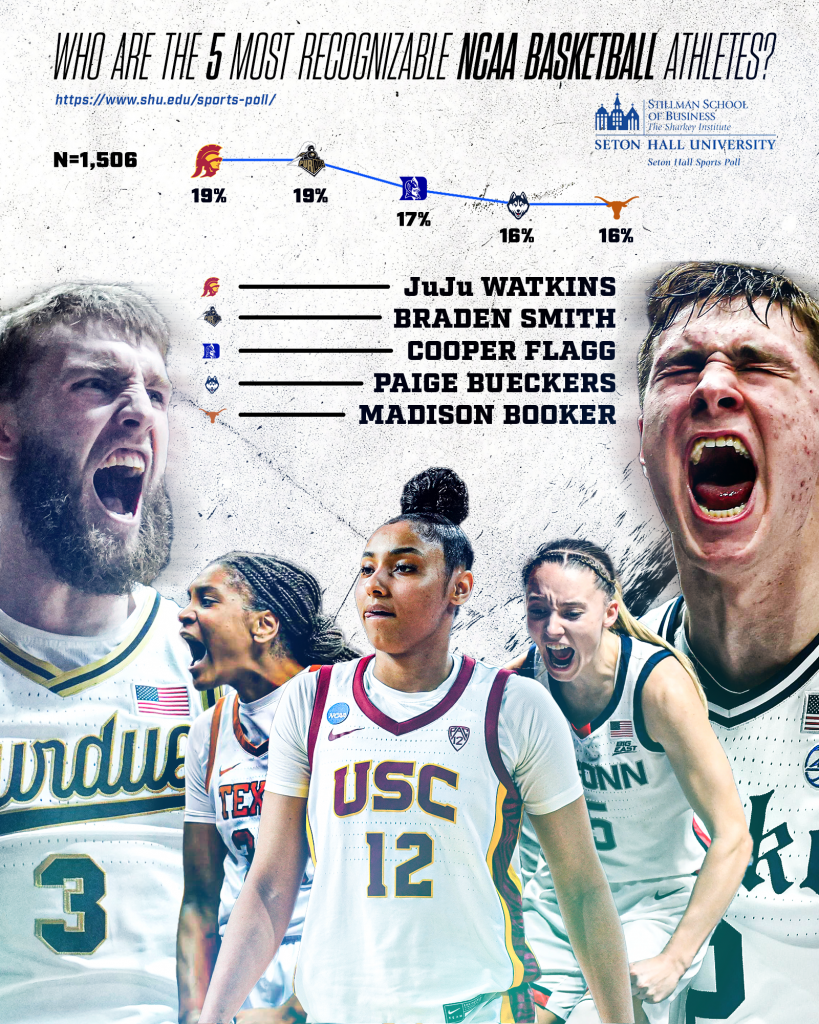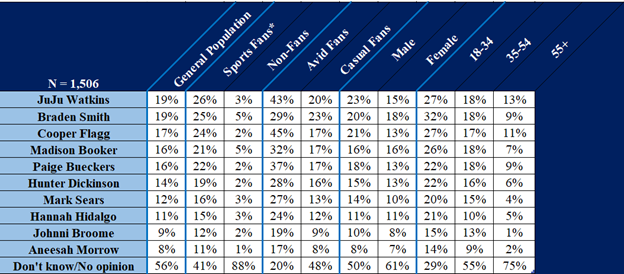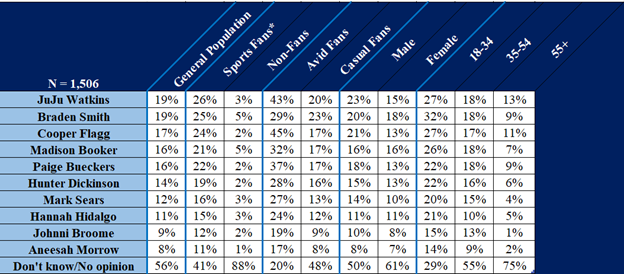- Three of Top Five Most Identifiable Athletes Are Female
- Fans Support Student Athletes Payment for Name, Image and Likeness
- The Caitlin Clark Effect is Real – Women’s Interest Declines 6 points from 2024

One of the products of college basketball’s “one and done” and the transfer portal is that women are now the most identifiable stars. USC’s JuJu Watkins, UConn’s Paige Bueckers and Texas’ Madison Booker are three of the five most well-known college basketball players heading into March Madness. When presented a list of ten top current male and female college players, Watkins, Bueckers and Booker were joined by Duke’s Cooper Flagg and Purdue’s Braden Smith in the top five.
“Women college basketball players stay in college longer than their male counterparts” said Daniel Ladik, Marketing Professor in the Stillman School of Business and Methodologist for the Seton Hall Sports Poll. “More seasons mean more time to build brand. Beyond additional court time, they have more opportunity within the new college NIL eco-system on campus.
These are the findings of the Seton Hall Sports Poll conducted March 4-6th among 1,506 adults across the country. The Poll, which is sponsored by The Sharkey Institute within Seton Hall University’s Stillman School of Business features a national representative sample from YouGov Plc. weighted on U.S. Census Bureau figures for age, gender, ethnicity, education, income and geography and has a margin of error of +/-3 percent.
Which of the following NCAA basketball players have you ever heard of? Please select all that apply.

Further insights from this question includes:
- Purdue’s Braden Smith merited the most support of any athlete the 18-34 subgroup with a third of the respondents (32%)
- Despite Smith being tied for the most known out of the general population, he was the least known of the top five to avid fans (29%)
- JuJu Watkins garners the most support of sports fans (26%) and males (23%)
- Awareness of Paige Bueckers increased to 16% in 2025 versus 10% in 2024
- Hunter Dickinson of Kansas has also generated more attention (14%) than in 2024 (11%)
- Freshman Cooper Flagg is recognized by 17% of the population, three points more than fifth-year athlete Dickinson
General Population Supports NIL Payments – Younger Fans Support More
After years of court litigation over the issue of amateurism in college sports, fans overwhelmingly support paying college student athletes for their name, image, and likeness. More than half (52%) of the general population believes students should be financially compensated for participating in March Madness. A majority of young fans support student athletes’ payment through alumni collectives (60%), NIL (69%), revenue sharing from conference and NCAA television rights (51%), and proportional payments between male and female athletes (50%).
“The public is apparently the most honest broker in the decades-long fight about the fair treatment of college athletes,” says Charles Grantham, Director of the Center for Sport Management in the Stillman School at Seton Hall University. “The next issues are the determination of the revenue, and whether the athletes will have a seat at the table.”
Do you think student athletes should be financially compensated, in addition to scholarship and cost of attendance stipends, for participating in either Men’s or Women’s NCAA March Madness Tournaments?

At several of the largest universities, alumni have banded together to pool their money to offer lucrative NIL deals to student athletes to attract them to play for their university. Do you think this is fair? To what extent do you agree with each of the following statements?

Further insights from these questions include:
- Avid Fans heavily support the stipend (70%) and collectives (57%)
- 75% of the 18-34 subgroup supports stipends for athletes
- 60% of 18-34 subgroup supports the collectives, i.e. alumni who have banded together to pool their money to recruit athletes
- 55+ subgroup has the lowest support for stipends (31%) or collectives (20%)
The Alston court decision (June 2021) requires that student athletes be paid for their name, image and likeness (NIL)

The recent House court settlement (October 2024) requires that certain student athletes share approximately 22% of the average Power 5 conferences (ACC, Big 12, Big Ten, Pac-12 and SEC) revenues paid to colleges.

The United States Department of Education recently terminated a Title IX sex discrimination policy that suggested NIL payments to college athletes must be proportionate between a school’s male and female athletes.

Further insights from these questions include:
- 75% of 18-34 subgroup support of name image and likeness deals
- 51% of the 18-34 subgroup support the share of the revenues which includes the television rights currently earned by NCAA March Madness
- 18-34 is the only subgroup to reach a 50% support level for proportional payments to male and female athletes
- Males and Females equally support (both 41%) the Title IX policy being applied
“Caitlin Clark Effect” working overtime?
The absence of Caitlin Clark has created a vacuum in NCAA Women’s college basketball. Interest in watching the Women’s March Madness tournament surged eight points from 2023 (40%) to 2024 (48%). This year, however, without Clark, interest dipped to 42% in 2025.
On the men’s side, there has been a slow growth in watchers with an annual two-point increase from 2023 to 2025 (51%-53%-55%). The 18-34 subgroup strongly supports collegiate basketball with 72% indicating that they will watch the Men’s 2025 March Madness tournament.
As women’s college basketball continues to gain momentum, the challenge will be sustaining and building on the attention Clark and other rising stars have brought to the sport. With growing fan interest and increased media coverage, the Seton Hall Sports Poll will continue to monitor NCAA Women’s Basketball.
On which devices, if at all, will you be watching any part of the NCAA Men’s 2025 March Madness college basketball tournament this year?

Further insights from this question include:
- NCAA Men’s March Madness tournament has had an annual two-point increase from 2023 to 2025: 2023 (51%), 2024 (53%), 2025 (55%)
- 93% of NCAA Men’s Basketball Fans subgroup said they will watch.
- 72% of the 18-34 subgroup said they will watch
- Only 41% of 55+ subgroup said they will watch
On which devices, if at all, will you be watching any part of the NCAA Women’s 2025 March Madness college basketball tournament this year?

Further insights from this question includes:
- Viewership of the NCAA Women’s March Madness has moved eight-points over the past three years with a high of 48% in 2024, a low of 40% in 2023, and 42% in 2025
- 71% of NCAA Women’s Basketball Fans say they will watch
- 61% of the 18-34 subgroup say they will watch
- Only 28% of 55+ subgroup say they will watch
March 2025 Seton Hall Sports Poll Results FINAL
Daniel Ladik, Ph.D., Chief Methodologist – daniel.ladik@shu.edu
This Seton Hall Sports Poll was conducted from March 4th to 6th and includes responses from 1,506 U.S. adults with a margin of error of +/- 3.0%. The sample mirrors the U.S. Census percentage on age, gender, income, education, ethnicity, and region.
Q1. Which of the following statements best describes you?

*Note: Avid + Casual = total sports fandom in the data. Some tables break out the Avid and Casual segments.
Q2a. What is your level of interest in NCAA Men’s Basketball?

Q2b. What is your level of interest in NCAA Women’s Basketball?

Q4a. For each of the following tournaments, please select on which devices, if at all, will you be watching this year’s NCAA Men’s 2025 Basketball March Madness tournament?

Q4b. For each of the following tournaments, please select on which devices, if at all, will you be watching this year’s NCAA Women’s 2025 Basketball March Madness tournament?

Thinking about the upcoming NCAA Men’s and Women’s March Madness college basketball tournaments…
Q5. Which of the following NCAA basketball players have you ever heard of? Please select all that apply.

And now a few questions about college athletes…
Q7b. Do you think student athletes should be financially compensated, in addition to a scholarship and cost of attendance stipend, for participating in either Men’s or Women’s NCAA March Madness Tournaments?

Q7c. At several of the largest universities, alumni have banded together to pool their money to offer lucrative NIL deals to student athletes to attract them to play for their university. Do you think this is fair?

To what extent do you agree with each of the following statements?
Q8a. The Alston court decision (June 2021) requires that student athletes be paid for their name, image and likeness (NIL).

Q8b. The recent House court settlement (October 2024) requires that certain student athletes share approximately 22% of the average Power 5 conferences (ACC, Big 12, Big Ten, Pac-12 and SEC) revenues paid to colleges.

Q8c. The United States Department of Education recently terminated a Title IX sex discrimination policy that suggested NIL payments to college athletes must be proportionate between a school’s male and female athletes.
